2017 AIGA Medalist: Nancy Skolos and Thomas Wedell
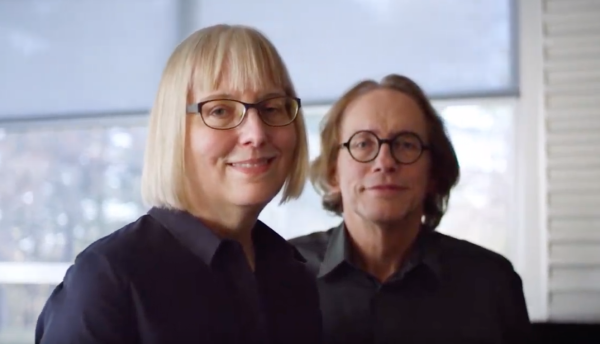
Recognition
2017 AIGA Medal
Born
Skolos: 1955, Cincinnati, Ohio
Wedell: 1949, Kalamazoo, Michigan
By CSusan Merritt
September 6, 2017
Recognized for pushing the boundaries of art, design, and technology with a distinctive vision to find connection among disparate forms.
The husband and wife duo of Nancy Skolos and Thomas Wedell exemplify a collaborative methodology emerging from a trusting partnership, insatiable curiosity, and a passion for process.
Skolos and Wedell met in 1975 as students at Cranbrook Academy of Art. Wedell was in his second year of graduate school in the photography department after completing a B.F.A. at the University of Michigan. Skolos had just transferred after two years in the industrial design program at the University of Cincinnati.
Wedell was smitten with Skolos from their first encounter, but she considered the popular graduate student to be out of reach. Plus, she wasn’t about to date him until she saw his portfolio. “I knew I couldn’t really like him if I didn’t like his work,” she says. By the time Wedell completed his M.F.A. the two were inseparable, and while she finished her B.F.A., he stayed on at Cranbrook to focus on graphic design. They married in 1979.
Cranbrook’s design department has always embraced an unstructured and interdisciplinary curriculum. “A lot of crossover happened when students from neighboring design disciplines worked side by side in the studio,” recalls Kathy McCoy, then co-chair of the design department. “That might have influenced Tom and Nancy’s hybrid approach, which blurs the boundaries between photography and graphic design, crisscrossing two- and three-dimensional form.”
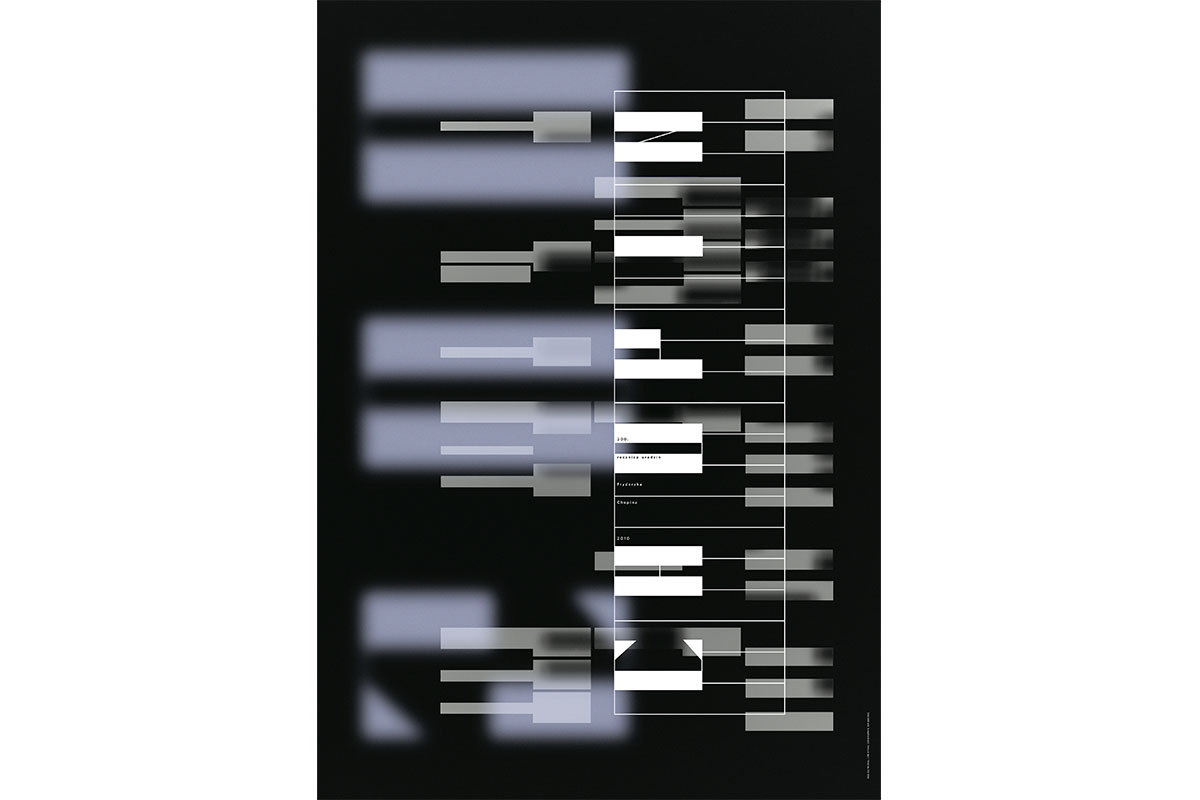
“Chopin 200,” 2010: This poster, celebrating the 200th birthday of composer Frédéric Chopin, won a gold medal in the special category Chopin Anew at the 22nd International Poster Biennale in Warsaw.
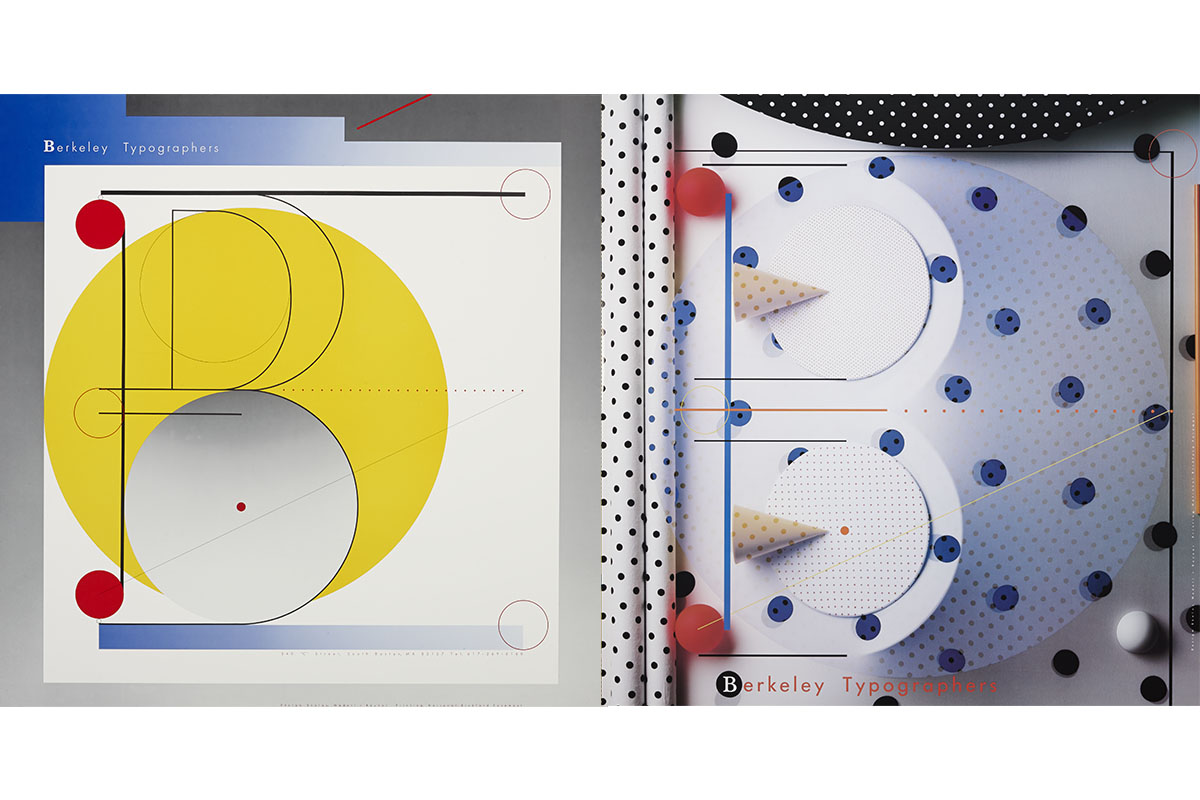
(Left): Berkeley Typographers, 1981. First in a series of three posters for Berkeley Typographers, a Boston-based photo-typesetting company. (Right): Second poster in the series, 1986.
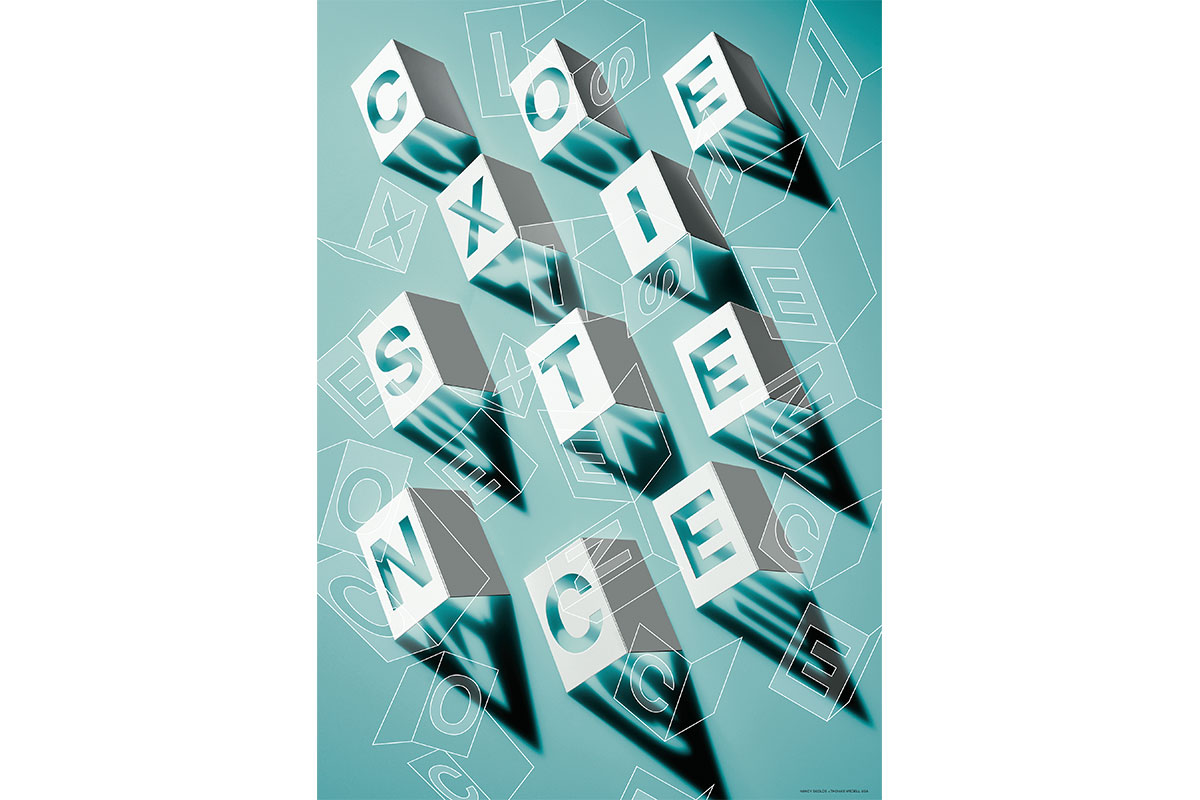
Photograph of Fred Ota, Tom Miller, John Weber, 1953. Thomas H. E. Miller Design Papers, Special Collections and Archives, University of Illinois at Chicago.
Following Cranbrook, Skolos joined Yale University’s graphic design program while Wedell held a full-time teaching position at the Swain School of Design, two and a half hours away. Weekend visits were spent working together. One of their early collaborations was a series of eight posters they designed for the Yale Symphony that reflected Skolos’ lifelong interest in music.
In 1980 they opened Skolos, Wedell + Raynor in Boston with partner Kenneth Raynor, who had also attended Cranbrook and had known Wedell since eighth grade. When Raynor moved back to Ann Arbor in 1990, the remaining pair carried on as Skolos–Wedell.
Skolos–Wedell’s earlier work covered a range of project types, including identities, collateral, exhibits, and packaging for computer companies, contract furniture companies, and architects. Gradually they began to focus on the poster as a primary format. “The poster format is like a threshold into another world. It frames an idea. It lets you play with amazing scale shifts,” says Skolos. Through these large-scale compositions, Wedell explains that they explore “the translation between three-dimensional form-making and the two-dimensional surface.” As 3D rendering programs and 3D printing flourish, they hope to utilize more organic and complex shapes. “There’ll be even more ambiguity between what’s digital and what’s physical,” says Skolos. “That should be really fun.”
Their process evolved over the years, influenced by changing interests. They belong to what Wedell calls the “bridge generation,” those transitional years when designers who were skilled in analog techniques shifted toward digital technology. “We understand both worlds and easily move between them,” says Wedell.
The 1982 poster promoting Skolos, Wedell + Raynor was an early experiment with building and photographing three-dimensional form. Later, as they made the leap into the digital realm, their work became more layered and complex. An excellent example is the promotional poster they designed for “Persona 2013: Skolos–Wedell Restrospective” an exhibition at the Wozownia Art Gallery in Toruń, Poland. They re-imagined the 1982 poster by duplicating the stair-stepped form out of Plexiglas, then photographed it, flipped it, and multiplied it digitally to create a dense pattern, thus bookending their three decades of work with the two posters.
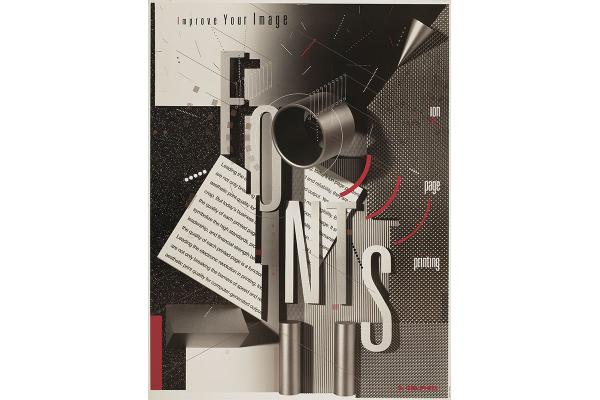
“Delphax,” 1987: Poster by Skolos, Wedell + Raynor highlighting the fonts created for Delphax high-speed, ion-technology office printers.
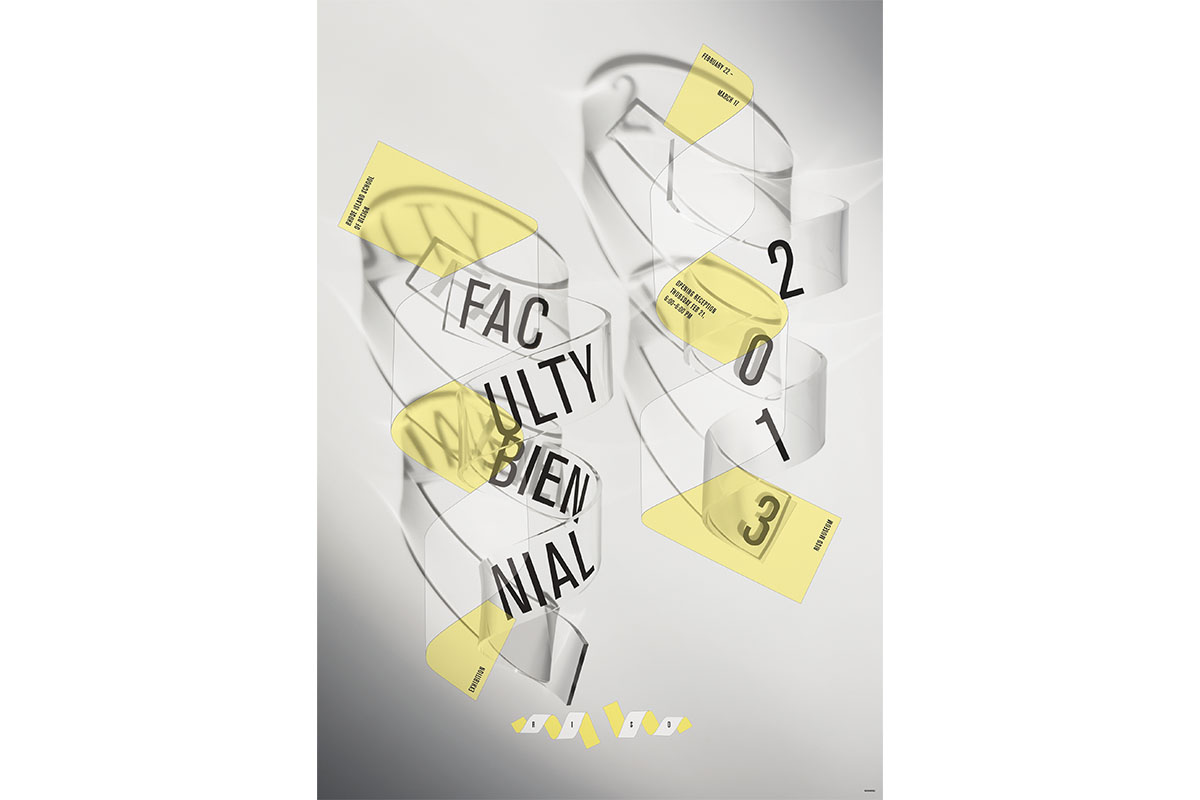
“Faculty Biennial,” 2013: Poster for a faculty exhibition at the Rhode Island School of Design Museum of Art.
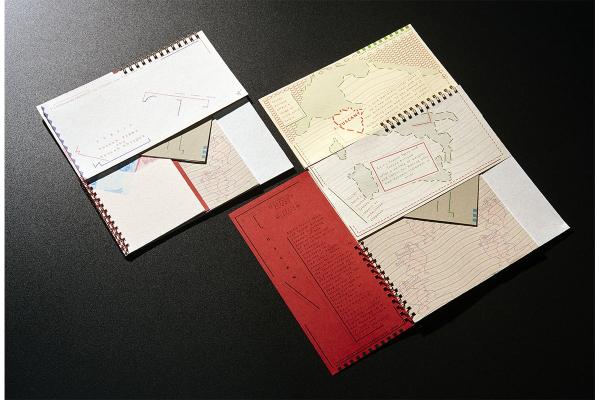
James River Paper Company, 1990: Promotional booklet designed to showcase James River Corporation’s Curtis Tuscan Terra and Tuscan Antique printing papers.
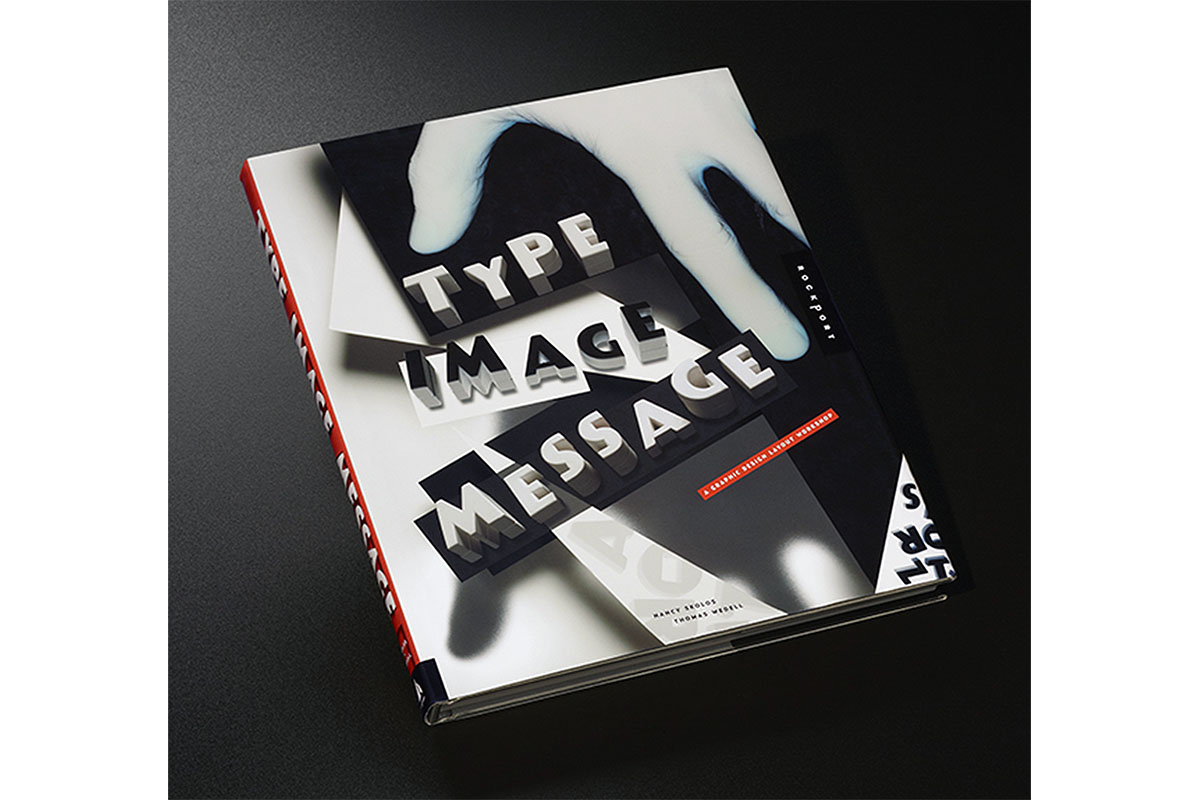
Thomas Miller, Detail from the DuSable mosaics, 1995. DuSable Museum of African American History, Chicago. Photograph: Chris Dingwall.
Inspired by cubism and early twentieth-century luminaries such as Kurt Schwitters, Hannah Höch, and László Moholy-Nagy, Skolos and Wedell flesh out ideas by assembling collages from salvaged bits of colored paper or magazines. Their interest in collage—forgoing a deliberate designing process—originated in the early stages of their careers while working with paste-ups. Scraps at the edge of the drawing board and layers of cut-up colored paper in flat file drawers provided provocative starting points. Occasionally the spontaneous paper collages even led directly to a final layout, such as with their 2012 commission for Public Bike.
Skolos and Wedell also work through concepts by sketching iterations on paper, sometimes literal, sometimes abstract. Initial concepts often evolve into elaborately constructed three-dimensional sets built from a wide range of material. This was the case with many of the Lyceum Fellowship student competition posters, their longest ongoing project—one a year since 1986, each based on a different theme. The construction phase is accompanied by what Mitch Goldstein, assistant professor in design at the Rochester Institute of Technology, calls the “analog-digital synthesis.” The models are photographed, digitally combined or enhanced, and finished off with typography. The result is deep, illusory space populated by shape, texture, color, and form that draws viewers in through the flat surface—a depth that harks to the Russian constructivists, especially the 1920s film posters of Vladimir and Georgii Stenberg.
“Like everyone, we’re inspired by things we see around us,” says Skolos. Once, in a hardware store, Wedell discovered a display of magnifying glasses in 12 different sizes. “We’ve got to do something with this,” he told Skolos. They bought the whole set and used it in a 2011 poster, Honoring Matthew Carter, to amplify a composition of Carter-designed typefaces.
Skolos–Wedell’s work has received countless awards and has been widely published and exhibited. Their posters reside in esteemed design archives including the Museum of Modern Art, Metropolitan Museum of Art, Cooper Hewitt, Smithsonian Design Museum, and others, and a collection of 65 posters can be found at Cranbrook and the Museum of Design, Zurich. In addition to their studio work, both are deeply involved in design education at Rhode Island School of Design—Skolos since 1989 and Wedell since 1993. Skolos is currently dean of architecture and design, and Wedell is a senior critic in the graphic design department. They present lectures about their work and methodology, and conduct poster design workshops worldwide.
Skolos and Wedell reside in a custom-designed house in Canton, Massachusetts, where they’ve lived and worked since 1999, with their two gregarious Norwegian Forest cats. When they moved in, Skolos joked that they weren’t moving their studio into their home but rather their home into their studio. Many visitors to the house have picked up on the visual similarity between their work and the architecture of their home. “There is a sense of surface, light, and dimension that makes it seem as if you are walking through one of our posters,” says Skolos. “Essentially our work is the material evidence of our relationship. We must get along really well if we can make something this harmonious.”
-
1949 Thomas Wedell born in Kalamazoo, Michigan
-
1955 Nancy Skolos born in Cincinnati, Ohio
-
1973 Wedell earns B.F.A. at School of Architecture and Design, University of Michigan
-
1973 Skolos begins studies in Industrial Design at University of Cincinnati
-
1975 Skolos and Wedell meet at Cranbrook Academy of Art
-
1976 Wedell earns M.F.A., Department of Photography, Cranbrook Academy of Art
-
1977 Skolos earns B.F.A., Department of Design, Cranbrook Academy of Art
-
1977 Wedell begins teaching graphic design at Swain School of Design
-
1979 Skolos earns M.F.A., Yale University School of Art
-
1979 Skolos and Wedell marry at Cranbrook
-
1980 Establish Skolos, Wedell + Raynor with Kenneth Raynor
-
1983 Skolos wins Progressive Architecture International Furniture Competition Award
-
1986 Design the first Lyceum Fellowship poster
-
1988 Work included in “The Modern Poster” at MoMA
-
1989 Skolos serves as critic at Rhode Island School of Design (RISD)
-
1990 Establish Skolos–Wedell when Raynor returns to Ann Arbor
-
1993 Labeled “techno-cubists” in March/April issue of Eye magazine, no. 8 vol. 2
-
1993 Wedell becomes senior critic in graphic design at RISD
-
1998 Appointed Richard Koopman co-visiting chairs at Hartford Art School
-
1998 Skolos elected to membership in Alliance Graphique Internationale
-
1999 Complete house and studio in Canton, Massachusetts
-
1999 Skolos serves as associate professor at RISD
-
2003 Skolos named AIGA Boston Fellow
-
2003 Skolos becomes department head in graphic design at RISD
-
2005 Skolos serves as professor of graphic design at RISD
-
2006 Co-author Type, Image, Message: A Graphic Design Layout Workshop
-
2011 Skolos becomes department head of graphic design at RISD
-
2012 Co-author Graphic Design Process: From Problem to Solution, 20 Case Studies
-
2013 Featured in “Persona 2013: Skolos–Wedell Retrospective” at Wozownia Art Gallery in Toruń, Poland
-
2014 Work included in “Designing Modern Women” at MoMA
-
2014 Skolos becomes dean of architecture and design at RISD
Sources
Aldersey-Williams, Hugh. Cranbrook Design: the New Discourse (New York: Rizzoli, 1990), 7.
Fenton, Steve and Lauria, Jo. Craft in America: Celebrating Two Centuries of Artists and Objects (New York: Clarkson Potter/Publishers, 2007), 175.
Resnick, Elizabeth. “In Tandem,” Graphis, May–June, 2003: 20–35.
“Thesis Book Story,” Design Observer. March 13, 2013, accessed December 27, 2016, http://designobserver.com/feature/thesis-book-story/38807.